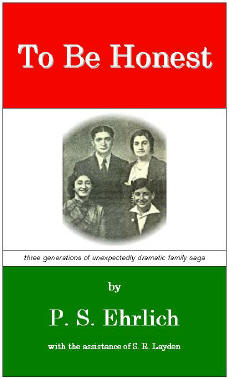 |
|
To Be Honest
Chapter 14 Left All by Ourselves
|
| click above to view a larger version of the book cover |
 |
|
To Be Honest
Chapter 14 Left All by Ourselves
|
| click above to view a larger version of the book cover |
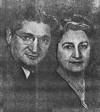 “We two old people,”
approaching but not quite fifty, celebrated their silver wedding anniversary in
July 1943. The years had not left them totally unmarked: they had grown
stouter, their hair was turning greyer, and both now wore glasses, though
Mathilda seldom let herself be photographed with them on. (In photos, when
not taken by surprise, the elder Ehrlichs almost always struck formal Old World
poses—standing very straight, hands folded, a pleasant but moderately
restrained smile on each face.)
“We two old people,”
approaching but not quite fifty, celebrated their silver wedding anniversary in
July 1943. The years had not left them totally unmarked: they had grown
stouter, their hair was turning greyer, and both now wore glasses, though
Mathilda seldom let herself be photographed with them on. (In photos, when
not taken by surprise, the elder Ehrlichs almost always struck formal Old World
poses—standing very straight, hands folded, a pleasant but moderately
restrained smile on each face.)
Joseph was fortunate to have
fairly sedentary work where he could set his own pace and his own hours.
He had developed arthritic back problems in the 1930s, and had to have George
oil the fur shop machines when he could no longer get down and reach under them
himself. Later on he would need to wear a corsetlike steel back brace.
Diabetes was diagnosed in the 1940s, and every morning Mathilda would take
insulin from the refrigerator, load a syringe, and give Joseph his shot.
(He always spoke very respectfully of Banting and Best, the discoverers of
insulin.) And Joseph’s hands began to tremble slightly, just enough to
make it difficult for him to write. This seemed to be another one of those
inevitable, unavoidable things associated with aging, and in this case another
good excuse to leave all the letterwriting to Mathilda.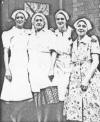
When Martha and George left home, their parents were left on their own for the first time since 1919 and their first year of marriage. With the children’s departure came the first chance for each generation to be independent of the other, a chance turned into certainty as the younger Ehrlichs got caught up, as did everyone their age in the family circle, in the Second World War. But the older European-born generation was on the other side now, in more ways than one. Eight thousand miles and an ocean away from home, they were steadfastly loyal to their adopted country and proud of their children’s military service to the same; yet they were separated from this World War as they had not been from the first one. And, despite their intense interest in global politics, they were dealing at a remove from reality.
In Chicago the Ehrlichs got letters from their family in Kolozsvár, letters which often made Mathilda cry.
Then, abruptly, the letters stopped coming.
![]()
For twenty years after World War I, the Jews of Hungary had been subjected to varying degrees of economic boycott and social ostracism. They had always hoped it would be a fleeting phenomenon, even when laws were passed* that defined “Jew” on an explicitly racial basis and restricted the number of Jews in Hungarian commerce and professions to twenty percent, then to five percent. Through it all they insistently proclaimed their undying patriotism, urging Hungary not to blindly emulate Hitler’s Third Reich.
The Hungarian government was in fact trying to placate the Nazis just enough to keep them at arm’s length. It was a perilous sort of balancing act, not made any the easier during World War Two by the Hungarians’s own geographic greed. In 1940 they demanded Transylvania back from the Romanians, who were isolated and demoralized by the recent collapse of their ally France. Romania† asked for German mediation, and Germany offered some “friendly advice”—to cede northern Transylvania, including Cluj/Kolozsvár, back to Hungary. The Romanian Foreign Minister took one look at the redrawn map and promptly fainted; yet his country had no choice but to swallow this especially bitter pill.
Transylvania’s Jews welcomed the return to Hungary, the nation to which they had retained such strong cultural and emotional ties, particularly the older folk who remembered the Golden Age. But new anti-Semitic measures were immediately introduced: Jewish children were prohibited from attending public schools, and only ten Jewish students (with special connections, which did not save them from being continually baited) remained at the University of Kolozsvár in 1940-41. Eight years earlier there had been 443 enrolled there.
By this time the Nazis had come up with their own solution to the Jewish Question—the Final Solution, in fact: they systematically rounded up millions of European Jews, put them on deportation trains, and sent them to death camps established in Poland. Rumors of this disturbed Miklós Kállay, the Hungarian Prime Minister. He pledged to “resettle” Hungary’s 800,000 Jews, but not until the Nazis provided a satisfactory answer as to where they were to be resettled. In the meantime the Kállay government jealously upheld Magyar independence, held firm against German pressure, and refused to deport a single Hungarian Jew.‡
So Hungary and northern Transylvania became a semi-sovereign island, an oasis in the wasteland Hitler was making of Europe. Eliminated from public life, segregated from the rest of Hungarian society, the Jews agreed that certainly these were unpleasant times; but whatever might be happening in other countries—and as the months went by there was an uneasy awareness of what was going on—well, it could never take place in their civilized homeland. It could never happen to them. Despite the harshness of their lives, they did continue to live, and if Kállay could continue parrying the Third Reich they would remain relatively well off. Surely it was best, then, to adopt the attitude of megusszuk: “We’ll get by.”
In March 1944 Hitler summoned old Regent Horthy to a meeting and there gave him an ultimatum: dismiss the Kállay government,§ or Germany would move in and occupy his country. Horthy agreed to Hitler’s demands, but that scarcely mattered; German troops were already marching across the Hungarian border. Kállay fled to Turkey and a new government was appointed, one that produced a landslide of anti-Semitic legislation. Jews were banned from most Hungarian stores, restaurants, and theatres; forbidden to use telephones or radios; required to stay indoors except for three hours each day; and ordered to wear the yellow star badge.
Adolf Eichmann came to Budapest and met with frightened Jewish leaders. He told them that any opposition would be mercilessly dealt with, but nothing would happen to the Jews if they “behaved” themselves. Any atrocities should be reported at once to Eichmann himself; he promised that immediate action would be taken, even against German officers. And he expressed polite interest in visiting the Budapest Jewish Museum and Library. His promises were half-believed; the Jewish leaders wanted to believe them. Maybe they would be safe if they cooperated, or at least played for time, since Nazi Germany’s defeat seemed imminent.
As for Eichmann, he was delighted with this “fantastic opportunity.”
From SS veterans throughout Europe he had assembled a Sondereinsatzkommando, his Special Operations Unit. Its members’s work elsewhere was pretty much completed; now all their attention and experience could be brought to bear on Hungary. They were ordered to proceed with due caution—the Nazis wanted to avoid another Warsaw ghetto rebellion—but they would have to hurry, especially in the east, for the Soviet army had almost reached the same Carpathian passes that the Cossacks had nearly pushed through thirty years before.
On May 2, 1944, the Kolozsvár police chief posted local ghettoization instructions. Then followed the banging on doors, the rounding up conducted by the Gestapo and the greenshirted Arrow Cross, Hungary’s own homegrown Nazis. Everything went smoothly enough, since few of the intimidated Jews dared resist.** Some of their Christian neighbors helped hide them; some denounced Jews in hiding; many feared being threatened with the same fate. And many others cheered as 12,000 Jews were herded into Kolozsvár’s Iris Brickyard by May 10th. Two weeks later another 4,000 joined them there.
The miserably overcrowded brickyard was exposed to wind and rain. A single pipe with fifteen faucets (frequently out of order) served as the ghetto’s water supply; there was hardly enough water for drinking or cooking, let alone washing. Food was doled out once a day. Four ditches were dug to be latrines for the entire brickyard. In one building—the “mint” or “massage room”—people were beaten into confessing where their valuables might be hidden.
Kolozsvár’s was a typical Hungarian ghetto.
On May 18th the Catholic Bishop of Transylvania, Áron Márton, gave a sermon in Kolozsvár at the Church of St. Michael, in front of which stood the bronze statue of Matthias Corvinus. And with the courage of Mátyás, Bishop Márton condemned the ghettoization, imploring Hungary not to abandon its Jews to annihilation. But articles appeared in local newspapers claiming that, despite exaggerated rumors, all was well at “the brickyard where people play football and rummy and nobody wants to work.” There was no hunger or disease or want for anything, and even if the Jews were not particularly comfortable in their ghetto, remember the brave Magyar soldiers fighting FOR us and BECAUSE of them!
Life in the ghetto in fact grew so intolerable that its inmates were glad to leave it, feeling relief when trains came to take them away. Seventy to ninety people were crowded into each freight car; all had to stand throughout the trip. There was no food, no water, no sanitation other than two buckets per car, and those who happened to die en route were not removed till the journey’s end. Upon arrival at their destination, the freight cars were emptied and columns were formed: one of men, the other of women and children. An SS doctor on sight-inspection divided each column into two groups.
Those who looked strong enough to work were sent to the right; there they were stripped, deloused, dressed in uniforms, and put to hard labor.
Those who looked old or sick or weak, children not yet in their teens, mothers who would not leave their children—these were sent to the left. There they were gassed and their bodies burned.
The ovens and gas chambers of Auschwitz were operating day and night.
![]()
Over 16,000 Jews were deported from the Kolozsvár ghetto; 150,000 from northern Transylvania; 437,000 Hungarian Jews in all. Most were sent to Auschwitz, where nearly 400,000 perished in a conveyor-belt blaze from mid-May to July 1944. Nothing was concealed; the Nazis operated openly, in full view of the world, and still brought off the most methodical and concentrated extermination in the history of the Holocaust.††
“It went like a dream,” boasted Eichmann.
The Allies, as in Béla Kun’s time, pretty much sat on their hands. They rejected a demand to bomb Auschwitz, defining it as a civilian target. Raoul Wallenberg, who would heroically rescue thousands from Budapest over the next six months, would himself be arrested by the baffled Russians—why should a Swedish diplomat risk his life to save Jews?—and never released; his fate remains a mystery.
Some efforts were made. Pope Pius XII and King Gustav of Sweden appealed to Horthy on behalf of the persecuted. The United States Congress called on the Hungarian people to “stem the tide of inhumanity.” On June 17th a rally in New York was sponsored by the Emergency Committee to Save the Jewish People of Europe. And, in one of history’s less piquant ironies, about 2,000 Hungarian Jews escaped across the Transylvanian border to a safe haven in Romania—despised Romania, so notorious for its anti-Semitic excesses through the past.‡‡ Ultimately northern Transylvania would be returned to the Romanians, and Kolozsvár would again become Cluj.
A vast number of people had
disappeared, vanishing into the nameless night and fog, not to be heard from
again. Their whispered fate was so dreadful that for a long while it was
dismissed as wartime propaganda. Some, for good or ill, have never
accepted or believed it.
A vast number of Mathilda and Joseph’s relatives had disappeared, and in later years they were seldom or never to be talked of. “I really don’t know what my parents knew about the Holocaust,” George was to say. “The grim reality of what in fact was happening to the relatives left in Europe... it was never really discussed. How could it be?”
The Ehrlichs and their extended
family were never ones for open mourning or public displays of grief.
“When the end for someone came, there was no great family outpouring; each
seemed to deal with it privately.” This was equally true whether the death
was of someone in the fullness of his years, like Sam Kohn, or in his prime like
Margaret Temmer’s younger son Alex. When Jenny Kohn died in the mid-1940s,
and again when Patsy the shepherd “went off somewhere to die,” George was not
told about it for a long time “so I wouldn’t feel hurt.”
Joseph and Mathilda would often
fend off “feeling hurt” in this manner. No candles were lit; if memories
proved too painful, they went unmentioned. In later years Mathilda might
recall her brother Náthán’s disappearance and her mother Berta’s death, but
“even now it makes me cry to think of that,” so the elder Ehrlichs resolutely
put the past behind them. Yet it could not be forgotten. On one
occasion (and one only) forty years after her family was lost, Mathilda was to
admit that she still dreamt of them, and wept for them. “We were almost a
city of our own, all related,” she would say. “And they were all killed.”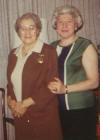
Surely it was best, then, to adopt the attitude of look to the survivors. Despite everything, a few were left in the Old World: Mathilda’s youngest sister Ili lived on in Paris, and their brother Jenő and his family would eventually make it to Israel. [See Appendix below.]
Meanwhile in America—there by the grace of Fate, or God, or a Vice-Consul’s rubber stamp—there were Martha and George. The children, raised as best Joseph and Mathilda could under the circumstances, were about to embark upon independent adult lives of their own. Their parents had always wanted a Better Life for them; now whether they were to enjoy it remained to be seen.
![]()
Proceed to Chapter 15 of To Be Honest
* The First Jewish Law (“A
Bill for the More Effective Protection of the Social and Economic
Balance”) was enacted in May 1938, partly to prevent takeover of the
Hungarian Parliament by the Arrow Cross. The Second Jewish Law (“A
Bill the Restrict Jewish Penetration in the Public Affairs and Economic
Life of the Country”) followed in May 1939.
† In Romania an Iron Guard had risen to power in 1937
and gone on an anti-Semitic rampage, particularly in territories like
Transylvania that had been annexed after World War I; there the Jews
were stripped of their citizenship, classed as foreigners, and
threatened with dismissal from their jobs. A year later Romania's
King Carol (whose mistress Magda Lupescu was Jewish) had the Iron
Guard leader Corneliu Zelea Codreanu imprisoned, then shot “while trying to
escape”; but Carol was forced to abdicate and flee Romania in 1940.
‡ Most Jewish men of military age, excluded from the
Hungarian army, were conscripted into forced labor battalions and
transported to the Russian front in Nazi-occupied Ukraine. In
Hungary a Third Jewish Law was enacted in August 1941, extending the
racial definition of “Jew” to include 100,000 Hungarians whom even the
Third Reich would not have considered Jewish.
§ During the summer of 1943, Kállay secretly conferred
with the Western Allies (he would not deal with the Soviet Union)
seeking a way for Hungary to remain neutral till the Allies could defend
it from German vengeance. But the West refused to exclude Russia
or make a separate peace.
** The Jews were told to list in quadruplicate all
their confiscated valuables—jewelry, watches, cameras, typewriters,
furs, rugs, paintings, silver, gold. One copy of the list was to
go to the city, the second to the police, the third left in the vacated
home or apartment; the Jews were allowed to keep the fourth copy.
†† On July 14, 1944, Secretary of State Cordell Hull
publicly confirmed the mass murder of Hungary's Jews. A day later
the New York Times gave further details in the article “Victims
of the Last Fury of the Nazis.”
‡‡ In 1942 Romania, no longer sure of German victory,
indefinitely postponed any deportation of their Jews. A stiff law
still forbade Jews illegally entering the country, but in 1944 this was
largely ignored and refugees were dealt with benignly.
![]()
Aufbau was founded in 1934 as a worldwide journal for German-speaking Jews. On page 19 of its March 9, 1945 issue (click here to view a PDF scan), among bilingual ads and announcements of births and weddings, is an article headlined Flüchtlinge in der Schweiz suchen Verwandte in U.S.A. This lists various refugees to Switzerland for whom American friends and relatives were searching, via the World Jewish Congress. Among the seekers was "Ehrlich, Josef (1553 Devon Ave., Chicago)," and those he sought were "Eugen Ivan Fried und Martha Kun."
When the present author stumbled across this list in 2007, I at first thought these were two people—a Mr. Fried and a Ms. Kun. But further Googling led me to the website www.kasztnermemorial.com, a tribute to Oskar Schindler's contemporary Rezső (Rudolph) Kasztner, whose bargaining with Eichmann's SS enabled the exchange of 1,684 Hungarians for three suitcases of cash, gold, jewels, and stock shares in 1944. Nearly a quarter of those rescued came from Kasztner's home town of Kolozsvár/Cluj, and among them were:
Kun, Jenő (Eugen) born December 26, 1897: a tailor
Kun-Rosenblatt, Fried[a] born October 28, 1903: a housewife
Kun, Ivan born May 10, 1928: a student
Kun, Martha born October 17, 1931: a student (called "the other Martha" by the Ehrlichs)
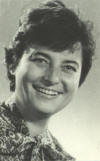 According
to Holocaust: Survivor List from the Files of World Jewish Congress
(browsable at ancestry.com) these were Prisoners #5588 through 5591 in
Bergen-Belsen's Block 11; and they were the only Kuns on
www.kasztnermemorial.com's
roster of the rescued.
Although the 1,684 on Kasztner's List were deported with the other
Hungarian and Transylvanian Jews in 1944, they went not to Auschwitz but
a "special section" of Bergen-Belsen. There they waited nearly six
months—July to December—for relocation to Switzerland. During this
time, "the other Martha's" shoes were stolen; yet with nothing else to
do she had memorized the pattern on their soles, and was able to track
the footprints to the thief and retrieve them.
According
to Holocaust: Survivor List from the Files of World Jewish Congress
(browsable at ancestry.com) these were Prisoners #5588 through 5591 in
Bergen-Belsen's Block 11; and they were the only Kuns on
www.kasztnermemorial.com's
roster of the rescued.
Although the 1,684 on Kasztner's List were deported with the other
Hungarian and Transylvanian Jews in 1944, they went not to Auschwitz but
a "special section" of Bergen-Belsen. There they waited nearly six
months—July to December—for relocation to Switzerland. During this
time, "the other Martha's" shoes were stolen; yet with nothing else to
do she had memorized the pattern on their soles, and was able to track
the footprints to the thief and retrieve them.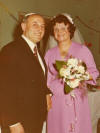
Eventually Jenő's family returned to Transylvania, which by then had been returned to Romania; but quite a few years passed before they were able to emigrate to Israel. Ivan Kun was an engineer or had some similar occupation, and Romania—whatever its opinion of Jews—was not eager to let engineers leave. The Kuns finally settled in Haifa by 1974, when Mathilda visited them there. But Rezső Kasztner's story lacked a happy ending: he was accused of collaboration with the Nazis, and in 1952 an Israeli court declared he had "sold his soul to the devil" for failing to warn the rest of Hungary's Jewish community about their impending fate. (It didn't help Kasztner's case that those he was able to rescue included his own extended family and friends.) The court's judgment was overturned in 1958, but a year earlier Kasztner had been assassinated—by a survivor of the Holocaust.
![]()
Last updated August 22, 2009
Return to the TO BE HONEST Index Page

Return to the Skeeter
Kitefly Websit
Copyright © 1986, 2003-2009 by P. S. Ehrlich; All Rights Reserved.